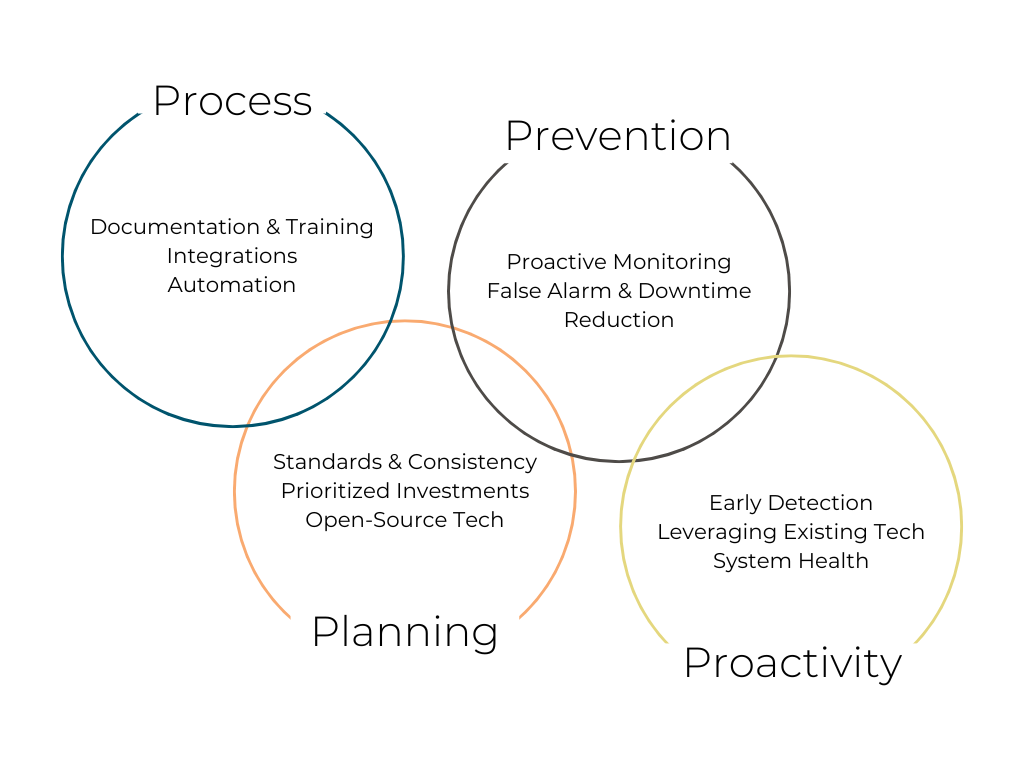Smart Strategies for Cost-Effective Security
The question isn't how much security costs.
It's how much poor security is already costing you.
Balancing Security and Budget: The Constant Battle
Security is often perceived as a necessary cost rather than a strategic investment. Whether you're running a healthcare facility, a school district, a manufacturing plant, or a corporate office, security systems are essential but not typically viewed as revenue-generating. However, when implemented thoughtfully, a cost-effective security approach can drive operational efficiency, reduce waste, and safeguard your organization from expensive disruptions.
Across industries, hidden expenses drain budgets and introduce unnecessary risk. By emphasizing Process, Planning, Prevention, and Proactivity, organizations can build a security strategy that is both fiscally responsible and highly effective.
The Hidden Costs of Inefficient Security
Many organizations underestimate how much inefficiency is costing them in terms of security. Without standardization or long-term planning, systems become fragmented and burdensome.
Inconsistent Infrastructure - Disparate security systems or alarm procedures across locations make staff training difficult and inflate maintenance costs.
Outdated Technology - In environments with legacy systems, unexpected breakdowns, downtime, and compliance risks become routine.
False Alarms - Repeated alerts desensitize staff and responders, wasting time, and increasing the chance of ignoring real threats.
Vendor Lock-In - Being tied to proprietary systems limits flexibility, makes upgrades more expensive, and slows down integration when organizations expand or merge.
All these inefficiencies result in drained resources and compromised security outcomes.
The Four P’s of Cost-Effective Protection
1. Process: Aligning Security with Operational Efficiency
Standardized processes lead to consistent results and better outcomes. Organizations should ask:
Are our security procedures documented, trained, and enforced consistently?
Are we leveraging automation and integrations to improve efficiency?
For example, an access control system that syncs employee credentials with alarm codes reduces errors and simplifies management. Automated panic buttons that simultaneously alert staff and secure doors can accelerate emergency response. Even features like quick video retrieval during incident reviews can save time and enhance accountability.
2. Planning: Avoiding Emergencies with Strategic Investment
Security should be a proactive investment, not a reactive expense. Regular audits help identify weak points, assess the health of your systems, and create a roadmap for phased upgrades.
A Three-Year Security Plan helps organizations spread out investments, prioritize high-risk areas, and avoid costly emergency replacements. Planning ahead for system end-of-life cycles ensures upgrades are timely and affordable.
Choosing open-platform technologies can also reduce long-term costs. Unlike proprietary systems, open or non-proprietary solutions allow organizations to choose the best technology and vendors for future expansion without being locked into expensive contracts.
3. Prevention: Minimizing Risk and Ensuring System Uptime
Preventive measures can drastically reduce the likelihood of security breaches, system failures, and compliance issues. This includes:
Monitoring system health and performance in real-time
Updating firmware and software regularly
Ensuring all devices (cameras, access readers, alarms) function properly
False alarms can be reduced by fine-tuning system settings and integrating video verification to confirm incidents before dispatching authorities. Even minor optimizations, like adjusting HVAC airflow away from motion sensors, can prevent frequent false triggers.
4. Proactivity: Anticipating Threats Before They Occur
Being proactive means staying ahead of threats with automation, analytics, and smart system management. Examples include:
Using video analytics to identify suspicious behavior before it escalates
Implementing automated alerts for equipment malfunctions
Integrating systems with HR tools to automatically manage user credentials
Additionally, service agreements with your security provider help manage maintenance and repair costs. These agreements typically include:
Predictable budgeting for maintenance
Faster response times for critical repairs
Long-term savings by avoiding emergency service fees
Cybersecurity is also a key piece of the proactive puzzle. Regular updates and patches help guard against evolving digital threats that can exploit outdated systems.
Key Strategies for Cost-Effective Security
To get the most out of your security investment, organizations should:
Standardize systems across locations to streamline training and reduce complexity
Eliminate false alarms to save time and avoid fines
Invest in scalable, open-platform solutions for future flexibility
Proactively monitor system health to prevent critical failures
Use a multi-year security roadmap to plan upgrades and spread out costs
Consider service agreements to avoid unplanned expenses and expedite repairs
Security That Works Smarter, Not Harder
Security doesn’t have to be a financial burden. With thoughtful strategy and the right technology, it can become a source of operational efficiency and peace of mind.
Rather than asking, “How much will security cost?” the better question is, “What will poor security cost us?”
By shifting from a reactive to a proactive approach and focusing on long-term sustainability, any organization can build a smarter, more cost-effective security infrastructure that supports growth and protects what matters most.
Ready to transform your security from a cost center to a strategic advantage? Get in touch.
Subscribe
Sign up for more industry tips, trends, and best practices from SecurAlarm.



